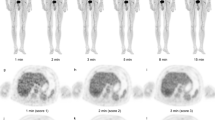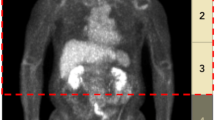Abstract
Objectives
To evaluate the effect of contrast medium dose adjustment for body surface area (BSA) compared with a fixed-dose protocol in combined positron emission tomography (PET) and computed tomography (CT) (PET/CT).
Methods
One hundred and twenty patients were prospectively included for 18F-2-deoxy-fluor-glucose (18F-FDG)-PET/CT consisting of a non-enhanced and a venous contrast-enhanced CT, both used for PET attenuation correction. The first 60 consecutive patients received a fixed 148-ml contrast medium dose. The second 60 patients received a dose that was based on their calculated BSA. Mean and maximum standardised FDG uptake (SUVmean and SUVmax) and contrast enhancement (HU) were measured at multiple anatomical sites and PET reconstructions were evaluated visually for image quality.
Results
A decrease in the variance of contrast enhancement in the BSA group compared with the fixed-dose group was seen at all anatomical sites. Comparison of tracer uptake SUVmean and SUVmax between the fixed and the BSA group revealed no significant differences at all anatomical sites (all P > 0.05). Comparison of the overall image quality scores between the fixed and the BSA group showed no significant difference (P = 0.753).
Conclusions
BSA adjustment results in increased interpatient homogeneity of contrast enhancement without affecting PET values. In combined PET/CT, a BSA adjusted contrast medium protocol should be used preferably.
Key Points
• Intravenous contrast medium is essential for many applications of PET/CT
• Body surface area adjustment of contrast medium helps standardise contrast enhancement
• Underdosing or overdosing of contrast medium will be reduced
• PET image quality is not influenced
• BSA adjusted contrast medium protocol should be used preferably in combined PET/CT



Similar content being viewed by others
References
Kitajima K, Murakami K, Yamasaki E et al (2009) Performance of integrated FDG PET/contrast-enhanced CT in the diagnosis of recurrent colorectal cancer: comparison with integrated FDG PET/non-contrast-enhanced CT and enhanced CT. Eur J Nucl Med Mol Imaging 36:1388–1396
Pfannenberg AC, Aschoff P, Brechtel K et al (2007) Low dose non-enhanced CT versus standard dose contrast-enhanced CT in combined PET/CT protocols for staging and therapy planning in non-small cell lung cancer. Eur J Nucl Med Mol Imaging 34:36–44
Pfannenberg AC, Aschoff P, Brechtel K et al (2007) Value of contrast-enhanced multiphase CT in combined PET/CT protocols for oncological imaging. Br J Radiol 80:437–445
Aschoff P, Plathow C, Beyer T et al (2012) Multiphase contrast-enhanced CT with highly concentrated contrast agent can be used for PET attenuation correction in integrated PET/CT imaging. Eur J Nucl Med Mol Imaging 39:316–325
Behrendt FF, Temur Y, Verburg FA et al (2012) PET/CT in lung cancer: influence of contrast medium on quantitative and clinical assessment. Eur Radiol 22:2458-2464
Mawlawi O, Erasmus JJ, Munden RF et al (2006) Quantifying the effect of IV contrast media on integrated PET/CT: clinical evaluation. AJR Am J Roentgenol 186:308–319
Fleischmann D (2003) Use of high concentration contrast media: principles and rationale-vascular district. Eur J Radiol 45:S88–S93
Prechtel HW, Verburg FA, Palmowski M et al (2012) Different intravenous contrast media concentrations do not affect clinical assessment of 18F-fluorodeoxyglucose positron emission tomography/computed tomography scans in an intraindividual comparison. Invest Radiol 47:497–502
Rebiere M, Verburg FA, Palmowski M et al (2012) Multiphase CT scanning and different intravenous contrast media concentrations in combined F-18-FDG PET/CT: effect on quantitative and clinical assessment. Eur J Radiol 81:e862–e869
Bae KT, Seeck BA, Hildebolt CF et al (2008) Contrast enhancement in cardiovascular MDCT: effect of body weight, height, body surface area, body mass index, and obesity. AJR Am J Roentgenol 190:777–784
Yanaga Y, Awai K, Nakaura T et al (2010) Contrast material injection protocol with the dose adjusted to the body surface area for MDCT aortography. AJR Am J Roentgenol 194:903–908
Yanaga Y, Awai K, Nakayama Y et al (2007) Pancreas: patient body weight tailored contrast material injection protocol versus fixed dose protocol at dynamic CT. Radiology 245:475–482
Livingston EH, Lee S (2001) Body surface area prediction in normal-weight and obese patients. Am J Physiol Endocrinol Metab 281:E586–E591
Behrendt FF, Bruners P, Keil S et al (2010) Effect of different saline chaser volumes and flow rates on intravascular contrast enhancement in CT using a circulation phantom. Eur J Radiol 73:688–693
Behrendt FF, Mahnken AH, Stanzel S et al (2008) Intraindividual comparison of contrast media concentrations for combined abdominal and thoracic MDCT. AJR Am J Roentgenol 191:145–150
Behrendt FF, Pietsch H, Jost G et al (2010) Intra-individual comparison of different contrast media concentrations (300 mg, 370 mg and 400 mg iodine) in MDCT. Eur Radiol 20:1644–1650
Behrendt FF, Plumhans C, Keil S et al (2009) Contrast enhancement in chest multidetector computed tomography: intraindividual comparison of 300 mg/ml versus 400 mg/ml iodinated contrast medium. Acad Radiol 16:144–149
Mahnken AH, Jost G, Seidensticker P, Kuhl C, Pietsch H (2012) Contrast timing in computed tomography: effect of different contrast media concentrations on bolus geometry. Eur J Radiol 81:e629–e632
Ho LM, Nelson RC, Delong DM (2007) Determining contrast medium dose and rate on basis of lean body weight: does this strategy improve patient-to-patient uniformity of hepatic enhancement during multi-detector row CT? Radiology 243:431–437
Heiken JP, Brink JA, McClennan BL, Sagel SS, Crowe TM, Gaines MV (1995) Dynamic incremental CT: effect of volume and concentration of contrast material and patient weight on hepatic enhancement. Radiology 195:353–357
Kormano M, Partanen K, Soimakallio S, Kivimaki T (1983) Dynamic contrast enhancement of the upper abdomen: effect of contrast medium and body weight. Invest Radiol 18:364–367
Platt JF, Reige KA, Ellis JH (1999) Aortic enhancement during abdominal CT angiography: correlation with test injections, flow rates, and patient demographics. AJR Am J Roentgenol 172:53–56
Gleeson TG, Bulugahapitiya S (2004) Contrast-induced nephropathy. AJR Am J Roentgenol 183:1673–1689
Behrendt FF, Mahnken AH, Keil S et al (2008) Contrast enhancement in multidetector-row computed tomography (MDCT) of the abdomen: intraindividual comparison of contrast media containing 300 mg versus 370 mg iodine per ml. Eur Radiol 18:1199–1205
Acknowledgement
This study was supported by an unrestricted grant from Bayer Healthcare AG, Berlin, Germany.
Hubertus Pietsch is an employee of Bayer Healthcare. Andreas Goedicke is an employee of Philips Technologie GmbH, Innovative Technologies, Research Laboratories, Aachen, Germany.
Patients from the fixed-dose protocol group were also included in a previous study from us, but the data of these patients were analysed again referring to the new objective of this study. Furthermore, patients from the BSA group were not included in any study before.
Author information
Authors and Affiliations
Corresponding author
Rights and permissions
About this article
Cite this article
Behrendt, F.F., Rebière, M., Goedicke, A. et al. Contrast medium injection protocol adjusted for body surface area in combined PET/CT. Eur Radiol 23, 1970–1977 (2013). https://doi.org/10.1007/s00330-013-2781-6
Received:
Revised:
Accepted:
Published:
Issue Date:
DOI: https://doi.org/10.1007/s00330-013-2781-6




